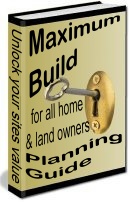
Development
of land, houses, extensions, conversions, internal alterations, local authority
planning consent, building regulations consent & all other development
matters.
Please use our carefully
selected featured links below to obtain information & quotes for all
types of development. This Article is FREE for anyone to
use.

TOPICAL
CONTENT......
Quick
links to our DEVELOPMENT guide
-
Developing guide | Siting and
layout | Building design | Resource
efficiency I Landscaping |
Construction | Fighting
pollution
Sustainable
Development

A checklist for
good environmental building
How
to use the checklist - The list is divided into eleven sections, each
of which covers a specific part of the potential building/development process.
Types and sizes of buildings and developments differ greatly and not all
sections and questions in the checklist will necessarily apply to
you.
To make reference
easy we have introduced a simple coding system which allows you to scan each
section for those areas which apply to you. Just check the list to find the
category your building/development falls into then follow the code through
the checklist.

1.
Siting and Layout
Quality streets
and open spaces
Does your scheme
re-use a previously developed site? If no, is there an alternative non-greenfield
site you could use? Does part of or all of the land need to be used? Can
existing buildings be re-used? Have you consulted the Council’s planning
staff concerning historic buildings (even if not listed) which may be affected?
Are any of the trees and hedgerows protected by law such as a tree preservation
orders? Is your site part of or near to a local nature reserve, a wildlife
heritage site, a wildlife link or a major landscape feature? Has a survey
and assessment been carried out to evaluate the ecological value of your
site? Bat roosts, badgers and their setts, and nesting birds are protected
by law. If you find a bat roost or a badger sett on your site you must contact
the Council’s Ecologist or English Nature straightaway.
Does your proposed
layout respect and conserve the existing land forms, water courses, vegetation
and wildlife habitats on the site? Have these been incorporated as positive
elements in the design of your scheme? Is there an opportunity to increase
areas of green space in your layout? Have efforts been made to maintain or
create links between the green spaces on your site and those adjoining or
nearby to assist wildlife movement? Have you consulted the Council’s
archaeology consultants about the location of important archaeological sites
which may be affected? Have you assessed the likely impact of the road and
service networks on the site and the surrounding area? Trees can be killed
by changes in the water table and wet lands and water courses may dry up.
Does the density of the development strike a good balance between efficient
land usage and amenity for the occupants?
WHY
NOT OBTAIN OUR MAXIMUM BUILD PLANNING
GUIDE
 New simple to understand
Planning Guide... "Puts dozens of strategies & risk assessments procedures
that you should be completing BEFORE you present a scheme for formal Planning
Approval in the UK." (Order your 'ebook' today & find out how the
'Professional Planning Consultant' prepares a scheme for residential development
PRIOR to formally submitting an extension scheme or full site redevelopment
to the Planners!). New simple to understand
Planning Guide... "Puts dozens of strategies & risk assessments procedures
that you should be completing BEFORE you present a scheme for formal Planning
Approval in the UK." (Order your 'ebook' today & find out how the
'Professional Planning Consultant' prepares a scheme for residential development
PRIOR to formally submitting an extension scheme or full site redevelopment
to the Planners!).
 Obtaining Planning Permission
for residential development in either extending your property or redeveloping
the site for new dwellings needs careful presentation & a risk assessment
prior to submitting for Planning Consent. A badly presented scheme to the
Planning Department by the Novice home owner can lead to an Automatic Rejection
& a Planning Refusal that could be hard to overturn. Our MAXIMUM BUILD
Guide will assist you in assessing your sites potential & what areas
you can exploit prior to submitting your scheme for Planning
Permission. Obtaining Planning Permission
for residential development in either extending your property or redeveloping
the site for new dwellings needs careful presentation & a risk assessment
prior to submitting for Planning Consent. A badly presented scheme to the
Planning Department by the Novice home owner can lead to an Automatic Rejection
& a Planning Refusal that could be hard to overturn. Our MAXIMUM BUILD
Guide will assist you in assessing your sites potential & what areas
you can exploit prior to submitting your scheme for Planning
Permission.
 click here
to find out more about our guide click here
to find out more about our guide |
Fight Pollution
Is your site easily accessible by public transport to save fuel costs? Can
provision be made as part of the development to improve or introduce public
transport access? Can the development be reached easily and safely on foot
or by bicycle? Will the development be easily accessible by a frequent public
transport service? Does the proposal include a Green Commuter Plan? Have
you minimised the amount of on-site car parking and provided plenty of secure
cycle and motor cycle parking? Have you designed your scheme to minimise
road lengths and the use of hard surface such as tarmac and concrete which
increase water run-off? Are parking areas arranged to avoid water run-off
into watercourses?
Energy Sense
- Does your layout take into account opportunities for solar heat gain?
Are you fully utilising topographical features and orientation to reduce
heat loss from exposure?
Reject Reduce
Re-use Repair Recycle - Does the layout have space for recycling bins
and composting facilities?
Introduction
Anyone planning to
develop or use land in from household extensions to major building schemes,
has a responsibility to ensure the change is one which protects the
environment.
In considering planning
and building control applications, Council takes into account, wherever possible,
the extent to which a new development or change of use will make a positive
contribution to the environment and the neighbourhood.
To make it easier
for developers, residents, businesses and landowners to understand the
environmental effects of a proposal a council has prepared this
guide.
It will help you
check the environmental consequences of a proposal before it is submitted
for planning permission. It will also help local residents to understand
how nearby development can be improved to reduce its impact on the local
environment.
NEXT
STEP - THE BUILDING REGULATIONS - OBTAINING BUILDING CONTROL
APPROVAL
 To compliment our Planning
Guide we have also produced a UK specific Specification Manual solely aimed
at the domestic/residential side of building. Are you completing your
own drawing plans for the Building Regulations as well? Why not obtain our
'Specification Manual' to assist you with obtaining Building Regulations
Approval as well. Alternatively you may have already secured Planning
Approval & just need this document. To compliment our Planning
Guide we have also produced a UK specific Specification Manual solely aimed
at the domestic/residential side of building. Are you completing your
own drawing plans for the Building Regulations as well? Why not obtain our
'Specification Manual' to assist you with obtaining Building Regulations
Approval as well. Alternatively you may have already secured Planning
Approval & just need this document.
 click
here to find out more about our Specification
Manual click
here to find out more about our Specification
Manual |

2.
Building Design
Quality streets
and open spaces - Does your design make a positive visual contribution
to the site and to adjacent areas? Has the design respected the character
of the area and of adjoining properties, particularly where these are listed
or in a conservation area? Have you thought of incorporating wildlife habitats
within the design of your building eg nesting lodges? Does your scheme design
cut opportunities for crime and provide an environment where people feel
it is safe to walk, cycle and play?
Energy sense
- Have you sought to minimise heat loss and maximise solar gain by sizing
windows according to the direction of the building? Is the height of your
building similar to those around it to prevent heat loss by exposure and
to reduce energy demands? Are your buildings grouped together for the same
reason? Can any parts of the development be designed as earth retained structures
to take advantage of soil heat? Have you designed for optimal thermal
performance? Remember the Building Regulations are the minimum standards
to aim at – think about extra insulation and double or triple glazing.
Are you aware that light can be a pollutant if its excessive use is a disturbance
to other people? Are you encouraging use of cycles by incorporating sheltered
and secure arrangements for cycle parking and changing and showering facilities?
Have you thought about converting your building for alternative use rather
than demolition and re-building?
Reject Reduce
Re-use Repair Recycle - Does your conversion retain as much of the original
built form as possible without necessitating demolition or other major works
which can be a waste of materials?

3.
Resource Efficiency
Conserve natural
resources - Is there an opportunity to use an active solar gain system
for supplementing conventional systems? Are there opportunities to introduce
alternative energy generating systems such as wind turbines or photovoltaic
equipment? Have you considered introducing control systems for water and
fuel, including water fuses and water softeners? Have you considered saving
water by using low/dual flush toilets, aerated tap and shower heads and
installing showers? Have you considered using grey water systems? Have you
designed in water butts?
Energy sense
- Have you paid attention to energy saving measures such as utilising heat
from water, the introduction of condensing boilers, zoning of heated areas
and minimum pipework distribution. Have you explored all opportunities for
energy efficiency lighting, introducing switching to avoid using electricity
in good daylight? Have you involved building managers to ensure that building
use is incorporated into energy efficient and environmentally sound design
and that there is an energy and water management system?

4.
Landscaping
Quality streets
and open spaces - Have you included as many green, soft, permeable surfaces
as possible? Have you considered how you can incorporate the habitat requirements
of birds, insects and mammals? Does your design make a positive contribution
to the visual and/or recreational amenity of this site? Have you considered
making full use of climbing plants to soften walls, fences and buildings?
Are you incorporating sufficient water features? For example, have you considered
feeding seasonal wetlands and ponds from roof run-offs and ditches? Have
you incorporated, where possible, "soft" boundary treatments such as hedges,
shrubs etc. Could you adapt or modify your landscaping design to ensure the
preservation of any land drainage ditches?
Conserve natural
resources - Does your design pay due regard to the existing natural features
of the site? Does your design take full advantage of the opportunities for
enhancing the nature conservation value of the site? Have you selected species
of known nature conservation value of the site? Have you drawn up a proper
management/maintenance plan for the ‘green’ elements of the site?
Does this discourage the use of peat, weedkillers and pesticides to reduce
environmental impact? Are you using turf and other materials from sustainably
managed sources?
Reject Reduce
Re-use Repair Recycle - Does your landscaping use materials generated
as waste from other works eg wood chippings?

5. Materials
Conserve natural
resources * - For most applications, softwood is just as suitable as
hardwood. If you must use hardwood is it from a registered sustainable source?
Can you avoid the use of PVC? For more information on sustainable materials
see Handbook of Sustainable Buildings (James and James Limited,
1998).
Fight pollution
- Are you using CFC- and HCFC-free insulation materials and refrigeration
equipment that uses the least damaging coolant for the
environment?
Reject Reduce
Re-use Repair Recycle - Can you use recycled materials in your scheme,
for example materials arising from demolition on site or
elsewhere?

6.
DrainageFight pollution - Have you installed interceptors in the
drainage system to prevent petrol, oil and other pollutants from washing
into nearby watercourses and ponds? How can you prevent storm water drainage
from polluting these watercourses?

7.
Construction
Quality streets
and open spaces - Can tree work be left until the winter? Can you avoid
work which affects animals during the spring breeding season? It is an offence
to disturb badgers, bats and birds. Are your car parks, site office and storage
areas positioned to cause minimum damage and disturbance to the site? Are
you sure that you have not denied wildlife access to and from their homes
and foraging areas?
Conserve natural
resources - Have you taken steps to safeguard landscape features and
vegetation during construction eg by erecting protective fencing around trees?
Have you taken steps to safeguard wildlife during construction eg by erecting
badger fencing? Have you marked out routes for construction vehicles which
avoid damage to the landscape and wildlife? Have you arranged for lights
to be turned off when construction work is not happening?
Fight pollution
- Is all your plant and equipment operating efficiently? Is it regularly
serviced to keep emissions, noise and fuel consumption to a minimum? Are
waste materials from the site recycled rather than disposed of – especially
if you are clearing out a building?

8.
Chemicals and hazardous materials
Fighting
pollution - Has a proper site investigation been carried out to identify
areas of soil contamination? Have you checked previous uses with the council?
Are correct measures being taken for decontamination? If you need to use
weedkillers or fertilisers, specify the type to be used. For more information
contact The Pesticide Trust. Are proper techniques being used on site for
the storage of diesel and bottled gas? If work is to be done to an existing
building, has all asbestos been located and correctly removed? Have lead-free
solders been specified for drinking water supply pipework? Check that the
bills of quantities include an item prohibiting the use of ozone depleting
aerosols, insulation materials and fire fighting equipment (this includes
HCFC’s and Halons). Are the painting materials you are using low on
volatile organic compounds (VOC’s)?

9. Some useful
contacts
Environment Agency,
Thames Regional Office, Kings Meadow House, Kings Meadow Road, Reading RG1
8DQ.
The Pesticide Trust,
The Eurolink centre, 49 Effra Road, London SW2 1BZ. Tel: 0171 274
8895
Friends of the Earth,
26-28 Underwood Street, London N1 7JQ. Tel: 0171 490 1555
Royal Society for
the Protection of Birds, The Lodge, Sandy, Bedfordshire SG19 2DL. Tel: 01767
680551
Berkshire Bat Group,
Caversham Court Environment Centre
English Nature, Fox
Hold House, Crookham Common, Thatcham, Berkshire RG19 8EL.
What is sustainable
development? - Development which meets the needs of the present without
compromising the ability of future generations to meet their own needs. -
Brundtland Commission, 1987
Sustainable
development is about changing what we do today to improve quality of life
and protect the environment, in balance with the local economy now and for
future generations.


Return to main Planning
guide |